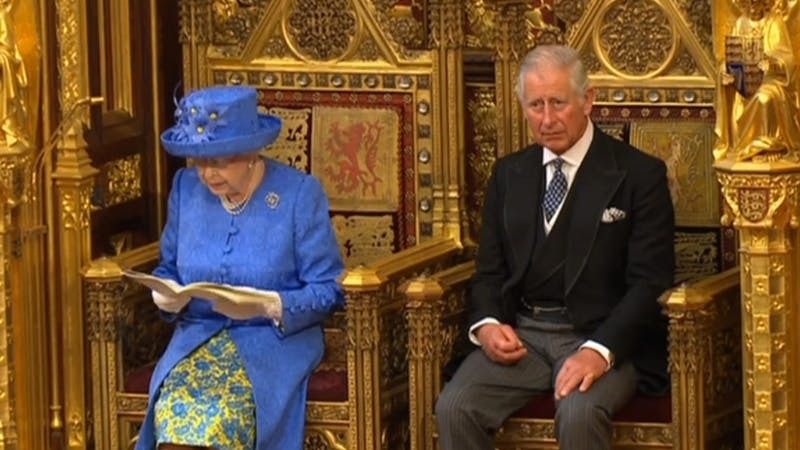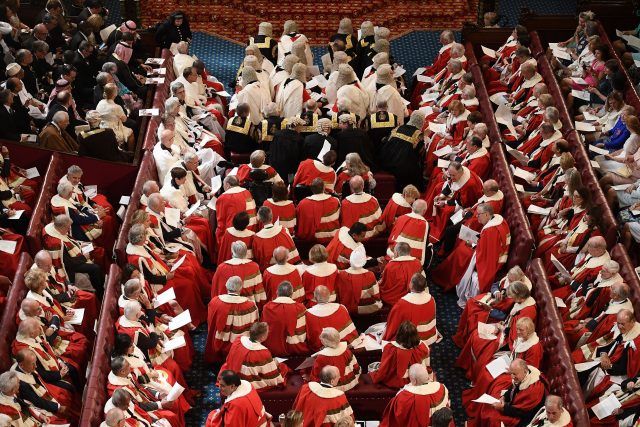
THERESA MAY has torn up much of the Conservative manifesto to deliver a legislative timetable for the next two years dominated by preparations for Brexit.
Of 27 Bills and draft bills unveiled in her first Queen’s Speech, eight are devoted to the complex process of withdrawal from the EU, including a Repeal Bill to overturn the 1972 Act which took Britain into the European Economic Community and separate Bills on customs, trade, immigration, fisheries, agriculture, nuclear safeguards and the international sanctions regime.
In the wake of the Grenfell Tower fire and a string of terror attacks, the Prime Minister also announced plans for a Civil Disaster Reaction Taskforce and a new Commission for Countering Extremism, as well as a review of counter-terror strategy and the creation of an independent public advocate to act on behalf of bereaved families.
But flagship manifesto policies which find no place in the Conservative agenda included the scrapping of universal free school lunches, means-testing of the winter fuel payment, an energy price cap and the reform of social care funding which opponents branded a “dementia tax”.
The Queen has delivered the #QueensSpeech in @UKHouseofLords. Read the speech in full: https://t.co/2wRLeK4ubq pic.twitter.com/vdHFGaEGHe
— UK Prime Minister (@10DowningStreet) June 21, 2017
The Queen also made no mention of any state visit by Donald Trump, fuelling speculation that the planned trip is set to be ditched after the US President reportedly said he did not want to come to the UK if there was a risk of being greeted by protests.
Following her failure to reach agreement with the Democratic Unionist Party on a deal to shore up her minority administration, Mrs May is the first PM in decades to be faced by doubts over whether she can get her legislative programme through Parliament.
Conservative sources said talks with the DUP were “ongoing” after the Northern Irish party warned its support cannot be “taken for granted”. But First Secretary of State Damian Green acknowledged that it may not be possible to reach a deal in time for the Commons vote on the Queen’s Speech package on June 29.
The #QueensSpeech sets out the govt’s agenda for Parliament’s working year https://t.co/7m0jXZnM9F pic.twitter.com/cn6ZOoQZbw
— House of Lords (@UKHouseofLords) June 21, 2017
Having called a snap election in the hope of securing an increased majority to deliver Brexit in a “strong and stable” way, Mrs May acknowledged that the outcome was “not the one I hoped for”.
“This Government will respond with humility and resolve to the message the electorate sent,” she promised.
#QueensSpeech will increase the National Living Wage so that the lowest paid see their wages go up. pic.twitter.com/F01xrnftSD
— UK Prime Minister (@10DowningStreet) June 21, 2017
“We will work hard every day to gain the trust and confidence of the British people, making their priorities our priorities.”
Also contained in the Queen’s Speech are Bills to extend the HS2 high-speed rail link to Crewe, permit the development of driverless cars and commercial satellites, cut whiplash insurance claims, protect victims of domestic abuse and ban letting fees for private rented homes.
Learn more about The Queen and Government: https://t.co/bXFbikjB4Q #QueensSpeech
— The Royal Family (@RoyalFamily) June 21, 2017
After the negative response to plans in the Tory manifesto to make pensioners pay for social care by selling their homes after they died, the Speech promised only a consultation on proposals which will be brought forward to improve social care.
It also said ministers would “bring forward measures to help tackle unfair practices in the energy market”, but made no mention of the cap promised during the election campaign.
#QueensSpeech will respond to the devastating life-long impact that domestic abuse has on children. pic.twitter.com/xwNrjORDQB
— UK Prime Minister (@10DowningStreet) June 21, 2017
The State Opening of Parliament, delayed by two days because of confusion caused by the inconclusive result of the June 8 election, took place without some of the traditional ceremony, with the Queen arriving by car rather than carriage and doing without her state crown.
Centrepiece of Mrs May’s programme is the Repeal Bill which will transfer relevant EU laws on to the UK statute book at the moment of Brexit in March 2019, with the aim of delivering “a smooth and orderly transition” and avoiding uncertainty for businesses and individuals.
The #QueensSpeech Repeal Bill will provide a functioning statute book on the day we leave the European Union. pic.twitter.com/jvBRoZeYMv
— UK Prime Minister (@10DowningStreet) June 21, 2017
Separate Bills will aim to ensure the UK has its own customs regime on exit and can operate an independent trade policy with Europe.
An Immigration Bill abolishes EU free movement rules after Brexit and provides a framework for the UK to control migration while attracting “the brightest and the best”.
An Immigration Bill will establish new national immigration policies once we leave the EU #QueensSpeech pic.twitter.com/oUcra0ARuZ
— UK Prime Minister (@10DowningStreet) June 21, 2017
A Fisheries Bill promises to restore UK responsibility over access and management of its waters, and an Agriculture Bill states the Government will introduce an “effective” system to deliver stability to farmers who lose EU support.
Other Brexit Bills create a new regime for nuclear regulation and safeguards after the UK quits Euratom, and enable Britain to make its own decisions on international sanctions.

Enjoy the convenience of having The Sunday Post delivered as a digital ePaper straight to your smartphone, tablet or computer.
Subscribe for only £5.49 a month and enjoy all the benefits of the printed paper as a digital replica.
Subscribe